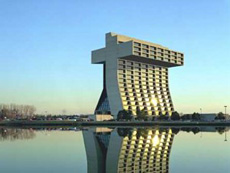Interesting effect at the Tevatron hints at new physics
 |
|
Fermilab's Wilson Hall in the shape of a t, the symbol for the top quark.
|
Scientists are finding signs of new physics through the study of a particle Fermilab
physicists discovered at the Tevatron, the top quark.
When top quarks and their anti-particles, anti-top quarks, are created in particle
collisions at the Tevatron, detectors note the direction in which they fly. Theory
predicts that the particles will favor one direction slightly over the other,
traveling that way about 5 percent of the time more.
However, in studies by the DZero collaboration and the CDF collaboration, the
particles seemed to be picky 15 percent of the time. Top quarks went forward and
anti-top quarks went backward. This month, the CDF collaboration announced results
with an even larger asymmetry.
They also recently released a study in which top quarks and their partners showed
this unexpected behavior almost half of the time in collisions above a certain
energy.
“It’s really challenging for us to construct a convincing theory to explain this,”
said theorist Susanne Westhoff, who presented on the subject at the Rencontres de
Moriond conference on Wednesday. “All of the proposed explanations involve a new
particle.”
Scientists think the cause of the unexpected asymmetry could be the interference of
an undiscovered particle, one just heavy enough to go undetected by the Tevatron. If
that’s true, experiments at the recently restarted Large Hadron Collider may be just
weeks from collecting enough data to find it.
The Higgs particle would not have this kind of effect, said physicist Fabrizio
Margaroli, CDF top quark group leader, who presented the experimental results at the
conference.
Read more
--Kathryn Grim
|